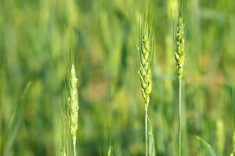Farming has its highs and lows and right now input prices are high while — despite our snowpack — soil moisture reserves are low.
This puts farmers into a high-stakes poker game where there could be considerable rewards for proper fertilizing but there could also be a penalty for skimping and starving your crop.
Retired soil scientists Cindy Grant and Don Flaten put their heads together and came up with a few ideas as to how farmers can play their cards this year. Flaten told the Manitoba Agronomists’ Conference earlier this winter about the strategy.
Read Also

New ranking elevates Assiniboine College to national research elite
Brandon’s Assiniboine College is 47th in a national ranking measuring research dollars and output at publicly funded institutions in Canada.
“I would say that for this coming year we should have a special formulation of 4R and I’m calling it EC,” Flaten said. “It’s Extra Careful for our stewardship because of the high stakes of high crop prices and high fertilizer prices.”
Pick up the cards, look at the hand and the first thing you see is last season’s drought. Over 90 per cent of the Prairies saw withering heat and very little rain leaving soil moisture reserves low. Spread out the hand, look at the cards, adjust for unknowns such as next year’s weather and market pressure and what pops up?
Soil nitrogen reserves are actually higher than usual. According to data published by AgVise there are relatively large amounts of leftover nitrogen because last year’s crop didn’t use very much.
“The average is quite high throughout Manitoba but there is still quite a bit of variability,” Flaten observed. “There are some fields that are in this normal range of let’s say, 20 to 40 pounds of N per acre but there are some with 60 pounds of N per acre, lots of variability.”
What this means is that with planning, testing, careful stewardship and a bit of luck, next year’s crop may do better than last year. The two important cards that farmers have up their sleeves are crop selection and nutrient management.
“We thought about some of the ways you can maximize your benefits and minimize the risk by matching crops strategically to the fields based on things like leftover nitrate nitrogen,” Flaten said. “Places where nitrogen is low may be areas where you target legumes or low-input crops like soybeans, lentils, peas, flax or oats.”
Other places where soil nitrogen is higher may be good for the high-input crops like canola, wheat or corn. You may let those crops reap the benefits of last year’s unused nitrogen and take an opportunity to “zig” while others are “zagging” on their crop choices.
“But, of course we want to respect crop rotations,” Flaten said. “You don’t necessarily want to put flax after canola, a non-mycorrhizal crop. Soybeans on high-nitrogen fields increase your risk of iron deficiency chlorosis so you don’t want to disrespect overall crop rotations with this strategy.”
Another card farmers may play is crop selection, seeding the best strains or species to take advantage of soil reserves. Pick a strain or hybrid that can get the best access to soil nutrients, come out of the ground fast, grow quickly and compete with the weeds. Early-season vigour is important so any agronomic tricks to achieve that are cards well played.
The next card in the hand goes back to applying this year’s fertilizer, the Extra Careful part of the game. Source, rate, time and placement are even more crucial this year so choosing optimums are vital.
“Manitoba is fortunate to have an N rate calculator,” Flaten said. “It’s a spreadsheet calculator that enables farmers and agronomists to enter their expected nitrogen fertilizer prices, their crop prices and their soil test reserves and then look at some scenarios and evaluate based on those prices.”
The spreadsheet is available through the Manitoba Government website and it requires five pieces of information that you can type in. Farmers or agronomists enter their expected nitrogen fertilizer prices and their crop prices, the soil test reserves and the calculator shows some scenarios.
From there they can make their evaluations of optimum fertilizer rates based on those prices. By typing in different data you can see different scenarios and come up with this spring’s application strategy.
Phosphorus is a little different and you won’t see the nice, neat response curves. There’s still a lot of variability so the question here is, should you think long term and build phosphorus out of need or take the short-term strategy and use just enough to get by this year and hope for better next year? Which cards should you play and which should you discard?
Applying just enough to get by is suitable for short-term land tenure when phosphorus is expensive relative to the crop price and may be suitable for one or two tight years. Flaten and Grant suggest a year like this may be the right time to consider going with a fairly modest rate of phosphate fertilizer and that’s typically what the Provincial Soil Fertility Guide recommends.
It also depends on the crop. There’s way more response with wheat and canola than for flax and soybean. If fertilizer cost is high and P is medium to high in the 20 ppm range, Flaten and Grant advise banding modest rates of starter P in a seed row to your cereals and canola and skip the phosphate for the soybean and flax.
“Overall we recommend farmers consider their long-term sustainability approach and if you aim to reach or maintain a soil test P range between 10 and 20 ppm you’d be building up on your low-P soils,” Flaten said. “If you’ve got more than 20 ppm you can just put on starter P and let that phosphate fertility bank support your crops for a while and not worry about it getting down too low.”
Micronutrients are also important and may be cards worth playing if the soil test recommendations indicate that they’re needed.
“I would recommend following the Soil Fertility Guide recommendations on this except for sulphur,” Flaten said. “I think sulphur is a relatively inexpensive nutrient to buy and it’s such valuable insurance, especially on canola crops. I think that’s something most canola growers would routinely apply.”
Visit the Manitoba Government website to find its nitrogen rate calculator.















